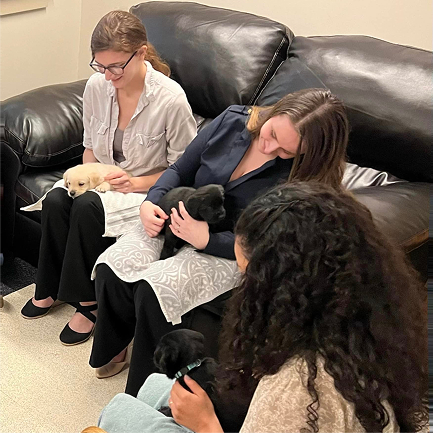

Canine partners for life
Canine Partners for Life (CPL) is a nonprofit organization dedicated to improving quality of life for individuals with visible and invisible disabilities by pairing them with professionally trained service dogs and companion dogs. After 35 years of making a difference, CPL was ready for a new look and partnered with First Ascent to update their website, logo, and branding. Our team was thrilled to be part of this project, driven by our own love for four-legged friends and our admiration for CPL’s work to bring people and dogs together.
Scope of Work
- Logo & Identity Design
- Website Design & Development
- Merchandise Design


Moving Forward with a Fetching New Look
CPL’s logo and brand identity had served them well since 1989, but after decades of growth, it was time for a refresh. As public understanding of disabilities has evolved, the old logo—focused on a wheelchair-aided person—no longer represented the full spectrum of individuals CPL serves. The new design aims to symbolize both visible and invisible disabilities, ensuring broader representation. We prioritized accessible typography and logo marks for those with cognitive disabilities or reading impairments.



Design that Aligns with Purpose and Partnership
Our collaboration with CPL involved discussions with staff, board members, and program graduates. Their invaluable insights guided our approach, emphasizing key themes like partnership, freedom, and commitment. The new logo features soft curves and a touch of blue to evoke compassion and trust. We also modernized the figure to reflect CPL’s diverse community and included details like eye contact and the CPL-specific harness to highlight the powerful connection between people and their service dogs.

Unleashing a New Digital Experience
To better align with CPL’s evolving mission and the needs of its community, our team worked to create a website that truly reflects the organization’s values and goals. The old site had become cluttered over the years with outdated content that no longer served its purpose, and was difficult to navigate. We created the new site to be sleek, modern, and interactive—designed to engage and serve the community. While we kept much of the original color palette and branding to evoke their legacy, we introduced a fresh, contemporary feel with the redesign that communicates CPL’s vision for the future.



Tail-Wagging Triumph
The launch of CPL’s refreshed logo and website was a resounding success, capturing the experience CPL strives to create—one rooted in connection, compassion, and partnership. The logo was first revealed in early 2024 at a special event, where one of CPL’s service dogs, Kokuma, nearly stole the show. As the logo was unveiled, Kokuma proudly trotted off with the covering, delighting the audience.
The response that followed was overwhelmingly positive, with one community member sharing, “I am so happy with the new logo that represents so many of our graduates and their partnerships. The intent in the eyes of the dog and human makes me want to look at it forever, like a painting that has the depth of so many feelings and love.”
The logo’s popularity has since continued to grow, even making a sweet appearance on custom cookies at CPL’s Spring Gala.

“First Ascent really connected with us and understood us in a way that made collaborating on such a large project feel seamless as our teams came together. We were so pleased working with their team. They’re wonderful professionals and really knowledgeable in branding and design. They were generous with both their time and their expertise. We can’t thank them enough for everything they’ve done, and it’s been really fantastic working with them.”
Kirstin Downie
Director of Development and Communications, CPL
award-winning results
Since its February 2024 launch, the website has demonstrated outstanding growth, achieving 62,496 sessions, 39,493 total users (including 71,597 new visitors), and 225,508 views—an 11% increase. Visitors now spend an average of 4 minutes and 42 seconds per session, a 74% improvement in session duration, with an engagement rate of 62.01%. The project’s success has been further recognized with multiple accolades, including a GDUSA Digital Design Award, an Anthem Award, and a Web Excellence Award.




